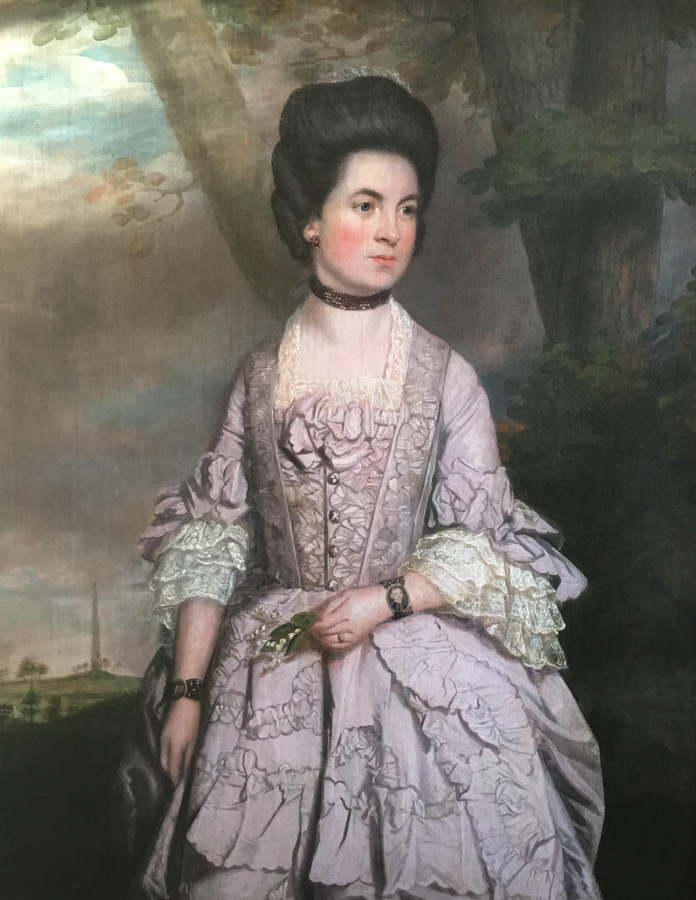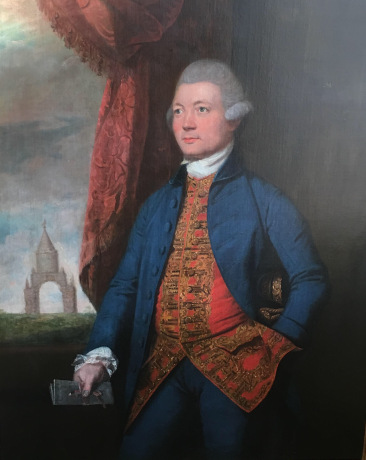Written and researched by Adam Busiakiewicz, Art Historian.
A month ago I undertook some research on two Georgian portraits for a client who had purchased them from an American auction house. Needless to say, the identity and attribution of the pair had been lost by the time they came up for sale. After a few hours work in the various London art libraries, the identity of the enigmatic sitters began to emerge from the books. The curious follies in the background of the paintings, a feature of many fine Georgian landscape gardens and parks, played an integral part in the re identification of the couple.
With kind permission from Nick Cox at Period Portraits, here are the notes I composed for the pair;
Thomas Beach (Milton Abbas 1738 – 1806 Dorchester)
Portraits of John Newman Esq. and Grace Newman.
Oil on canvas
50 x 40 5/8in., 127 x 103.19cm. (2)
Bears the date 1768.
PROVENANCE
John Newman Esq. of Barwick (d. 1799), Yeovil; by descent through the marriage of his daughter Lucy to;
George Messiter (1776-1834); by descent
Messiter family collection till at least 1970s;
Private collection Virginia from at least 1987.
LITERATURE
Jones, Follies & grottoes, London 1974, second edition, p. 227;
Headley, W Meulenkamp, Follies grottoes & garden buildings, London 1999, p. 455;
J. Bond, Somerset parks and gardens, a landscape history, Tiverton 1998, p. 95.
NOTE
Until recently, the identity of this remarkable pair of Georgian portraits had been lost. They depict Somerset landowners John Newman Esq. and his wife Grace Newman of Barwick, Yeovil. (1) Although little is known about their lives, their identities are confirmed by the distinctive and unmistakable follies depicted in the backgrounds of their portraits.
Follies were fashionable architectural embellishments to gardens and parks from the sixteenth century onwards. By the eighteenth century, wealthy Georgian landowners erected these pieces of architectural fancy for both reasons of pleasure and morbidity. Not only would these gothic monuments, sham castles, pyramids and classical temples provide focal points for landscape gardens, they would in many examples reflect the personality of the architect and patron freed from rules of taste and tradition. Often built with the passing of time in mind, these structures also reflect the transience of life on earth.
The follies of Barwick have always presented somewhat of a puzzle to historians. In the portrait of John Newman, we see the so-called Jack the Treacle Eater folly, described by writers on the subject as “as fine as any in the country and for enigma cannot be surpassed”. (1) Local legend claims that it was erected to house a famous runner who lived inside the tower of the folly. This Jack is said to have ran messages to and from London trained on treacle alone. Both the portrait and surviving structure bear witness to a statue of Mercury on top of the cylindrical cone, a feature that was often used to mark out the boundaries of estates.
The portrait of Grace Newman depicts another of the follies in the estate, known as the Rose Tower or the Barwick Park Cone. This marvellous hollow stone structure, measuring around twenty one metres, has been described as unique in Britain. (2) The hollow cone stands on a tripod consisting of three gothic arches, and tapers to a slender point on which ends with a ball finial. Despite previous suggestions that it may have served as a dovecot, it has rightly been described as “a highly functional structure designed for no function that has yet materialized” (3). Although both of these follies had been previously suggested to be the work of George Messiter in the 1820s, these portraits confirm the earlier date of c.1770. The surviving grotto at Barwick, which Pevsner attributed to this phase of Georgian work likened to those carried out at Stowe, is equally as fascinating and mysterious. (4) The piece of paper held in John Newman’s hand, which reads ‘1768 Survey…’, indicates that these portraits were likely to have been commissioned to celebrate his improvements to the park and house at Barwick.
Barbara Jones, the authority on the folly in Britain, is the first to have identified the couple as John and Grace Newman. She was shown these exact portraits before the second edition of her book was published in 1974. (5) Her note suggests that they were both still in the possession of descendants of Newman family at this point. The Georgian building at Barwick was remodelled in the 1820s, and the family fell into financial problems towards the end of the nineteenth century. The house and follies still stand to this very day.
Although the pair are unsigned, there is little doubt in regards to the authorship of painter Thomas Beach. In exuberant painterly style and composition, they show a considerable indebtedness to Sir Joshua Reynolds, with whom Beach was a pupil in London from 1760 till around 1762. Both Newman portraits were produced during the final years 1768-70, before the painter moved to the fashionable spa town of Bath. A portrait of Mary Newman by Beach, signed and dated 1768, perhaps John Newman’s eighty-four year old mother, was sold Sotheby’s, New York, 4 June 1987, lot 130.
During this early period of his career, Beach tended almost exclusively to patrons local to his native Dorset and Somerset. (6) Beach’s greatest patrons during this early period were the Helyar family of Coker Court, of whom Beach produced a staggering twelve portraits in total. The Helyars were neighbours to the Newmans of Barwick, and are separated by a less than two and a half miles. Beach’s portrait of William Helyar (d.1820) captures the architectural aspirations of his proud sitter, showing him holding a finely drawn plan of the new wing at Coker Court. The attention to architecture is equally as important in the Newman portraits, and points towards the pride and ambition of the patrons who commissioned them.
The pair sold at auction in London in May 2017.
Written and researched by Adam Busiakiewicz.
(1) They married in 1767. A surviving deed (DD/HK/54) explains that Grace Newman, nee Hoskins, was the sister to William Hoskins of Haselbury Plucknett, Somerset.
(2) See Headley & Meulenkamp, p.455.
(3) Ibid. p. 455.
(4) See Jones, 1974, p. 229.
(5) J. Orbach, N. Pevsner, The buildings of England: Somerset: South and West, London 2014, p. 110.
(6) See Jones, 1974, p. 227.
(7) E. S. Beach, Thomas Beach, a Dorset portrait painter, London 1934, p. 6.






